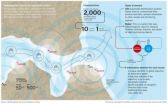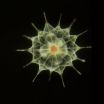(Press-News.org) Tobias Brügmann and his colleagues from the University of Bonn's Institute of Physiology I used a so-called "channelrhodopsin" for their experiments, which is a type of light sensor. At the same time, it can act as an ion channel in the cell membrane. When stimulated with blue light, this channel opens, and positive ions flow into the cell. This causes a change in the cell membrane's pressure, which stimulates cardiac muscle cells to contract.
"We have genetically modified mice to make them express channelrhodopsin in the heart muscle," explains Professor Dr. Bernd Fleischmann of the Institute for Physiology I. "That allowed us to change the electric potential of the mouse heart at will, enabling us to selectively produce conditions such as arrhythmia of the atrium or the ventricle."
These types of arrhythmia - physicians also call them ventricular fibrillation - are among the most common causes of death after a heart attack. They develop when large quantities of cardiac cells die and are replaced with connective tissue. "This scar tissue has a different electrical activity than the healthy heart muscle," says the leader of the study, Professor Dr. Philipp Sasse. "And that makes the heart stumble."
But why is that so? Normally, electric impulses spread across the heart from a natural pacemaker. This happens in a temporally and spatially tightly controlled manner, creating a closely coordinated contraction. However, if entire muscle areas decouple electrically, this mechanism no longer works: all of a sudden, certain parts of the heart pulse at their own rhythm. This causes the blood flow to come to a near-standstill.
The scientists from Bonn can now trigger this decoupling through photostimulation. They can target just a few cells at a time or direct larger areas of the heart, allowing them to find out, for instance, which areas of the hollow muscle are especially sensitive to electric disruptions.
But why not simply stimulate the heart muscle with electrodes in order to make the heart lose its rhythm? "That can be done as well," says Professor Sasse. " But this method has unwanted side effects: if the electric stimulation lasts longer than a few milliseconds, toxic gases are produced, and the pH value changes."
The consequences of a heart attack, which leads to permanent tissue damage, can of course only be studied in a very limited form when using short-term electric stimulation. Photostimulation is much more suitable: the cells will even withstand stimulations of several minutes at a time without problems.
Using channelrhodopsin in medical research is not fundamentally new, although so far it has mainly been used in neuroscience. For instance, scientists can use these light channels to direct the behavior of flies and mice - with nothing but blue light.
INFORMATION:
Contact information:
Professor Dr. Philipp Sasse
Institute for Physiology I
Life&Brain-Center at the University of Bonn
Telephone: +49 (228) 6885-212
E-Mail: philipp.sasse@uni-bonn.de
Professor Dr. Bernd K. Fleischmann
Institute for Physiology I
Life&Brain-Center at the University of Bonn
Telephone: +49 (228) 6885-200
E-Mail: bernd.fleischmann@uni-bonn.de
Bonn researchers use light to make the heart stumble
Method allows for completely new approaches to researching dangerous arrhythmia
2010-10-05
ELSE PRESS RELEASES FROM THIS DATE:
DNA art imitates life: Construction of a nanoscale Mobius strip
2010-10-05
The enigmatic Möbius strip has long been an object of fascination, appearing in numerous works of art, most famously a woodcut by the Dutchman M.C. Escher, in which a tribe of ants traverses the form's single, never-ending surface.
Scientists at the Biodesign Institute at Arizona State University's and Department of Chemistry and Biochemistry, led by Hao Yan and Yan Liu, have now reproduced the shape on a remarkably tiny scale, joining up braid-like segments of DNA to create Möbius structures measuring just 50 nanometers across—roughly the width of a virus particle. ...
Hebrew University research holds promise for development of new osteoporosis drug
2010-10-05
Jerusalem, October 4, 2010 – Researchers at the Hebrew University of Jerusalem have discovered a group of substances in the body that play a key role in controlling bone density, and on this basis they have begun development of a drug for prevention and treatment of osteoporosis and other bone disorders.
The findings of the Hebrew University researchers have just been published in the American journal PNAS (Proceedings of the National Academy of Sciences).
The research group working on the project is headed by Prof. Itai Bab of the Bone Laboratory and Prof. Raphael ...
Disappearing glaciers enhanced biodiversity
2010-10-05
Biodiversity decreases towards the poles almost everywhere in the world, except along the South American Pacific coast. Investigating fossil clams and snails Steffen Kiel and Sven Nielsen at the Christian-Albrechts-Universität zu Kiel (CAU) could show that this unusual pattern originated at the end of the last ice age, 20.000 to 100.000 years ago. The retreating glaciers created a mosaic landscape of countless islands, bays and fiords in which new species developed rapidly – geologically speaking. The ancestors of the species survived the ice age in the warmer Chilean north.
The ...
A step toward lead-free electronics
2010-10-05
Research published today by materials engineers from the University of Leeds could help pave the way towards 100% lead-free electronics.
The work, carried out at the UK's synchrotron facility, Diamond Light Source, reveals the potential of a new manmade material to replace lead-based ceramics in countless electronic devices, ranging from inkjet printers and digital cameras to hospital ultrasound scanners and diesel fuel injectors.
European regulations now bar the use of most lead-containing materials in electronic and electrical devices. Ceramic crystals known as 'piezoelectrics' ...
Ancient Colorado river flowed backwards
2010-10-05
Palo Alto, CA—Geologists have found evidence that some 55 million years ago a river as big as the modern Colorado flowed through Arizona into Utah in the opposite direction from the present-day river. Writing in the October issue of the journal Geology, they have named this ancient northeastward-flowing river the California River, after its inferred source in the Mojave region of southern California.
Lead author Steven Davis, a post-doctoral researcher in the Department of Global Ecology at the Carnegie Institution, and his colleagues* discovered the ancient river system ...
An eye for an eye
2010-10-05
Revenge cuts both ways in the Israeli-Palestinian conflict. Scientists of the University of Zurich, the Massachusetts Institute of Technology, and Tel Aviv and Quinnipiaq Universities show that attacks by either side lead to violent retaliation from the other. Both Israelis and Palestinians may underestimate their own role in perpetuating the conflict.
A team of scientists from the University of Zurich, the Massachusetts Institute of Technology, and Tel Aviv and Quinnipiaq Universities have found that attacks by both Israel and Palestinians lead to violent retaliation ...
When docs counsel weight loss, it's style that makes a difference
2010-10-05
DURHAM, N.C. – Most doctors are spending a good deal of time counseling their patients about diet and weight loss, but for the most part, it isn't making any difference, according to a new study appearing in the American Journal of Preventive Medicine.
Duke University Medical Center researchers recorded the conversations between 40 primary care physicians and 461 of their overweight or obese patients over an 18-month period. Investigators didn't tell them what they were listening for – only that they wanted to record the encounters to see how doctors talked about health. ...
Researchers find possible biomarker to identify seizure-related stress
2010-10-05
PROVIDENCE, RI -- New research from Rhode Island Hospital found that reduced levels of brain-derived neurotrophic factor (BDNF), a protein in the brain that encourages growth of neurons, may be a trait marker for individuals with psychogenic non-epileptic seizures (PNES) (seizures that are psychological in origin). The findings are published in the October 4, 2010, issue of Neurology, the medical journal of the American Academy of Neurology.
Past studies have shown decreased levels of BDNF in the serum of patients with psychiatric disorders such as major depressive disorder ...
An intelligent system for maritime surveillance has been created
2010-10-05
The system has been designed by scientists from this Madrid university for Núcleo CC, a company which develops surveillance systems for the maritime and aeronautic sectors. The first prototype will be used in the near future in Cape Verde (Africa). Two types of sensors have been deployed there: a set of radars and a series of AIS (Automatic Identification System), which allow ships to communicate their position and give other relevant data on their location and characteristics. These two types of sensors offer complementary data which can be fused in order to obtain better ...
MBL scientists reveal findings of World Ocean Microbe Census
2010-10-05
LONDON, UK—After a decade of joint work and scientific adventure, marine explorers from more than 80 countries, including six scientists from the Marine Biological Laboratory (MBL), today delivered the first global Census of Marine Life revealing what, where, and how much lives and hides in the world's oceans. In one of the largest scientific collaborations ever conducted, more than 2,700 scientists spent over 9,000 days at sea on more than 540 expeditions gathering the data.
As a result of these efforts the scientists discovered that there may be up to 1 billion kinds ...
LAST 30 PRESS RELEASES:
Discovery on how aggressive breast cancer controls protein production
A simple blood test can predict Crohn’s disease years before symptoms appear
FAU study reveals social, family and health factors behind teen bullying
New alliance trial seeks to reduce delays in gastrointestinal cancer treatment
Discovery of a new superfluid phase in non-Hermitian quantum systems
Codes in the cilia: New study maps how Cilk1 and Hedgehog levels sculpt tooth architecture
Chonnam National University researchers develop novel virtual sensor grid method for low-cost, yet robust, infrastructure monitoring
Expanded school-based program linked to lower youth tobacco use rates in California
TV depictions of Hands-Only CPR are often misleading
What TV gets wrong about CPR—and why it matters for saving lives
New study: How weight loss benefits the health of your fat tissue
Astronomers surprised by mysterious shock wave around dead star
‘Death by a thousand cuts’: Young galaxy ran out of fuel as black hole choked off supplies
Glow with the flow: Implanted 'living skin' lights up to signal health changes
Compressed data technique enables pangenomics at scale
How brain waves shape our sense of self
Whole-genome sequencing may optimize PARP inhibitor use
Like alcohol units, but for cannabis – experts define safer limits
DNA testing of colorectal polyps improves insight into hereditary risks
Researchers uncover axonal protein synthesis defect in ALS
Why are men more likely to develop multiple myeloma than women?
Smartphone-based interventions show promise for reducing alcohol and cannabis use: New research
How do health care professionals determine eligibility for MAiD?
Microplastics detected in rural woodland
JULAC and Taylor & Francis sign open access agreement to boost the impact of Hong Kong research
Protecting older male athletes’ heart health
KAIST proposes AI-driven strategy to solve long-standing mystery of gene function
Eye for trouble: Automated counting for chromosome issues under the microscope
The vast majority of US rivers lack any protections from human activities, new research finds
Ultrasound-responsive in situ antigen "nanocatchers" open a new paradigm for personalized tumor immunotherapy
[Press-News.org] Bonn researchers use light to make the heart stumbleMethod allows for completely new approaches to researching dangerous arrhythmia




